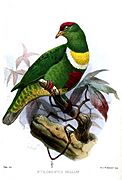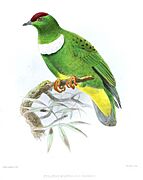White-bibbed fruit dove facts for kids
Quick facts for kids White-bibbed fruit dove |
|
|---|---|
 |
|
| Ptilinopus rivoli bellus. Male | |
| Conservation status | |
| Scientific classification | |
| Genus: |
Ptilinopus
|
| Species: |
rivoli
|
The white-bibbed fruit dove (its scientific name is Ptilinopus rivoli) is a beautiful type of bird. It belongs to the Columbidae family, which includes doves and pigeons. These colorful birds are known for their bright feathers and love for fruit.
Contents
Different Kinds of Fruit Doves
Just like there are different breeds of dogs, there are different kinds of white-bibbed fruit doves. These are called subspecies. They are slightly different versions of the same bird, often living in different places.
Here are some of the subspecies:
- Ptilinopus rivoli bellus - Found in places like New Guinea, Karkar Island, and Goodenough Island.
- Ptilinopus rivoli miquelii - Lives on islands such as Yapen and Meos Num, which are north of New Guinea.
- Ptilinopus rivoli prasinorrhous - Can be seen in the Aru Islands, West Papuan Islands, and Geelvink Bay Islands.
- Ptilinopus rivoli rivoli - This specific type lives on Umboi Island.
- Ptilinopus rivoli strophium - Found in areas like Egum Atoll (Trobriand Islands) and the Louisiade Archipelago.
Where These Doves Live
The white-bibbed fruit dove lives in a part of the world called Oceania. You can find them in the Maluku Islands, New Guinea, and the Bismarck Archipelago. They also live on many smaller islands near New Guinea.
Some of the islands where these doves are quite common include Buru, Seram, and Karkar.
Their Natural Home
These doves prefer to live in habitats that are warm and wet. Their favorite places are moist lowland forests and mountain forests. They mostly live in old, untouched mountain forests. However, you might also find them in forests that have grown back after being cut down, though not as many.
In New Guinea, they usually live high up in the mountains, between 1,000 and 3,260 meters (about 3,280 to 10,695 feet) above sea level. But on smaller islands like the Aru Islands Regency, they can also be found closer to sea level. They mostly stay in the tops of trees, among the branches and leaves.
What White-Bibbed Fruit Doves Look Like
The white-bibbed fruit dove is a medium-sized bird. It can grow to be about 23.5 to 26 centimeters (around 9 to 10 inches) long. It's a bit smaller than an African collared dove, but it has a more compact body. Its tail is shorter and rounded.
Male and female white-bibbed fruit doves look different. This is called sexual dimorphism.
- Males have a bright purple cap on their head, which is very noticeable.
- Females are mostly green all over their bodies.
Both sexes have mostly dark green feathers. They have a large white band on their chest that looks like a crescent moon. This band can sometimes have a yellowish color, depending on the subspecies. The color of their belly and the underside of their tail also changes with the subspecies. Some have a long, narrow purple spot on their belly. Their tail feathers are often bright yellow. However, in some subspecies, the belly is pure yellow, and the tail feathers are green. Their beak is a bright yellow color.
Life Cycle and Habits
The white-bibbed fruit dove loves to eat fruit! It's a fruit-eating bird. They usually pick fruits right from the tree branches. You won't often see them looking for food on the ground.
When it's time to build a nest, they use twigs. The female dove usually lays two eggs. This is a bit unusual for fruit pigeons that live in New Guinea, as many others lay only one egg.




